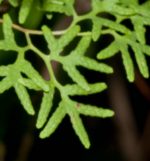 This twining deciduous vine is one of 40 species of climbing fern vines and is native to low open woods, sandy clearings, streambanks, and bog margins from Maine to Ohio south to Georgia and Mississippi. It grows 5-15 feet long and has wiry stems and hand shaped fronds with 5-7 finger-like lobes. It has two types of fronds, fertile and infertile, with the fertile ones being smaller and found at the tips of the stems. Plants are considered endangered or threatened in parts of New England and adjacent states and have been protected in Connecticut since 1869 to curb rampant collection of the plant for Christmas decorations. The plants are difficult to grow because of their need for constant moisture, high light levels, and very acid soil. American climbing fern is a good choice for a bog garden. The genus name, Lygodium, comes from the Greek word lygos meaning willow like or plant and probably refers to the stems. The specific epithet, palmatum, comes from the Latin word palma meaning palm of the hand and refers to the shape of the pinnules.
This twining deciduous vine is one of 40 species of climbing fern vines and is native to low open woods, sandy clearings, streambanks, and bog margins from Maine to Ohio south to Georgia and Mississippi. It grows 5-15 feet long and has wiry stems and hand shaped fronds with 5-7 finger-like lobes. It has two types of fronds, fertile and infertile, with the fertile ones being smaller and found at the tips of the stems. Plants are considered endangered or threatened in parts of New England and adjacent states and have been protected in Connecticut since 1869 to curb rampant collection of the plant for Christmas decorations. The plants are difficult to grow because of their need for constant moisture, high light levels, and very acid soil. American climbing fern is a good choice for a bog garden. The genus name, Lygodium, comes from the Greek word lygos meaning willow like or plant and probably refers to the stems. The specific epithet, palmatum, comes from the Latin word palma meaning palm of the hand and refers to the shape of the pinnules.
Type: Twining vine
Bloom: Not applicable
Size: 5-15’ long
Light: Sun/abundant light
Soil: Average, very moist to wet, acid
Hardiness: Zones 4-8
Care: Careful selection of the site is critical for success.
Pests and Diseases: None of significance
Propagation: Spores
Companion Plants: Plants that need highly acidic soils such as azaleas, holly, and creeping phlox